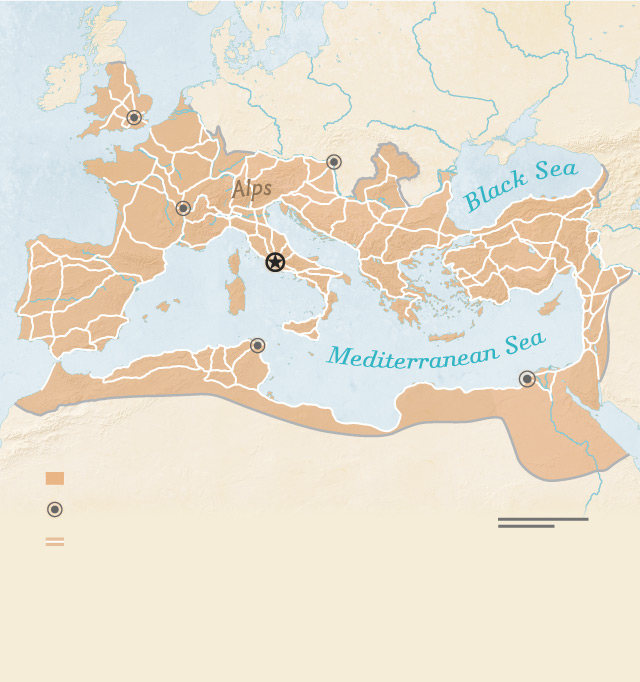
Begun in 312 B.C., the Appian Way is perhaps the most famous Roman road of all. It first united Rome with Capua and then was extended south to the port city of Brundisium on the coast of the Adriatic.
RICCARDO AUCI
200,000 miles of Roman roads provided the framework for empire
Built during the republic and empire, a vast network of roads made moving goods and troops easier through all corners of the Roman world.
By Jesús Rodríguez Morales
National Geographic
January 21, 2021
Ancient Rome was famous for many things, many of them big and flashy. Gladiators, triumphs, and emperors often spring to mind, but perhaps Rome’s most enduring contribution to history is more humble: their roads (which all led back to Rome), a vast, interconnected network spanning as many as 200,000 miles at its maximum.
Across Europe, parts of North Africa, and the Middle East, the remnants of these roads can be found crisscrossing the landscape, from Scotland to Mesopotamia, from Romania to the Sahara. Rome’s earliest roads were built to connect the city on the Tiber with other cities on the Italian Peninsula. As Rome’s influence grew, their system of roads expanded too. They became arteries connecting new territories and their peoples to Roman civilization and eventually the Roman Empire. Some 30 roads from all points of Italy connected with Rome, many bearing the names of their builders, such as the Appian Way named for Appius Claudius, or the names of their destinations, such as the Ardeatina Way that led to Ardea, about 24 miles from Rome.

Roads were Rome’s “DNA” from the very beginning. Begun in 451 B.C. and finished a year later, the Lex XII Tabularum, or Law of the Twelve Tables, was the earliest set of written policies. Inscribed on 12 bronze tables, they spelled out procedures for trials, property ownership, crime and punishment, and civil rights. They also included rules for the road, setting a standard width of eight Roman feet for straight roads and 16 for curved ones (one Roman foot is slightly longer than a foot in the modern Imperial system).
The Appian Way
The Via Appia, or Appian Way, is perhaps the most famous Roman road. Paved with large basalt slabs, it was built in the fourth century B.C. at the direction of Censor Appius Claudius. At first, the road connected Rome to Capua, about 132 miles away in the Campania region of Italy. By 244 B.C. the road had been extended south more than 200 miles to reach the port city of Brundisium (modern Brindisi) on the Adriatic coast of southern Italy. (See a fourth-century map where all roads really do lead to Rome.)

View Images
Elected censor in 312 B.C., Appius Claudius, whose name appears on this 4th-century B.C. inscription, sponsored two signature Roman works: the Via Appia (Appian Way) and the Acqua Appia, Rome’s first aqueduct. DEA / ALBUM
Because the road became the main conduit from Rome to the Adriatic ports and the Mediterranean, the Appian Way became a crucial component of Rome’s economy as well as its military. It was wide enough for two carts to pass in opposite directions or for five soldiers to march side by side. Building the Appian Way was a massive undertaking, but the excellent craftsmanship of the road was apparent for centuries. First-century A.D. Roman poet Statius called it longarum regina viarum (queen of the long roads). Writing hundreds of years after its construction, the sixth-century A.D. Byzantine historian Procopius also lauded its engineering:
Begun in 312 B.C., the Appian Way is perhaps the most famous Roman road of all. It first united Rome with Capua and then was extended south to the port city of Brundisium on the coast of the Adriatic.
RICCARDO AUCI
'建設, 建築' 카테고리의 다른 글
| Architecture: From Prehistory to Climate Emergency review – how energy shaped the way we built the world (0) | 2021.05.30 |
|---|---|
| When Is the Revolution in Architecture Coming? (0) | 2021.05.11 |
| 울퉁불퉁 거친 돌을 근정전 마당에 깔아놓은 뜻은 (0) | 2020.03.15 |
| 9 Most Beautiful Houses of Worship Around the World (0) | 2019.09.30 |
| Was Architecture Better Under Socialism? (0) | 2019.02.04 |